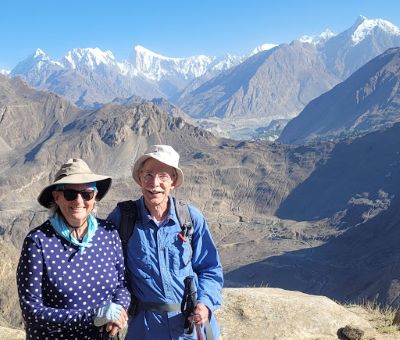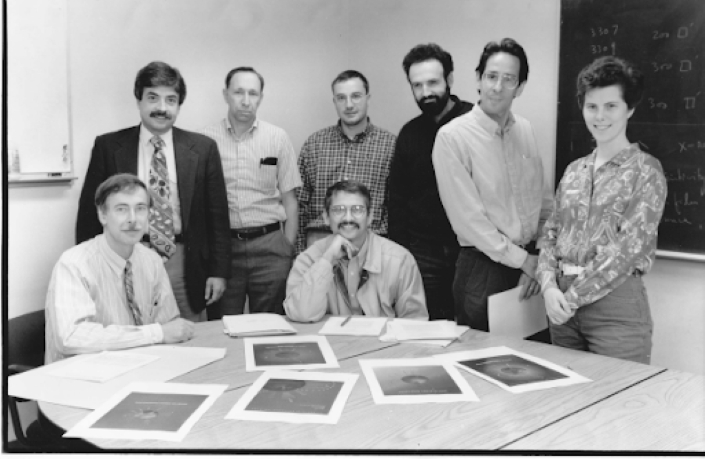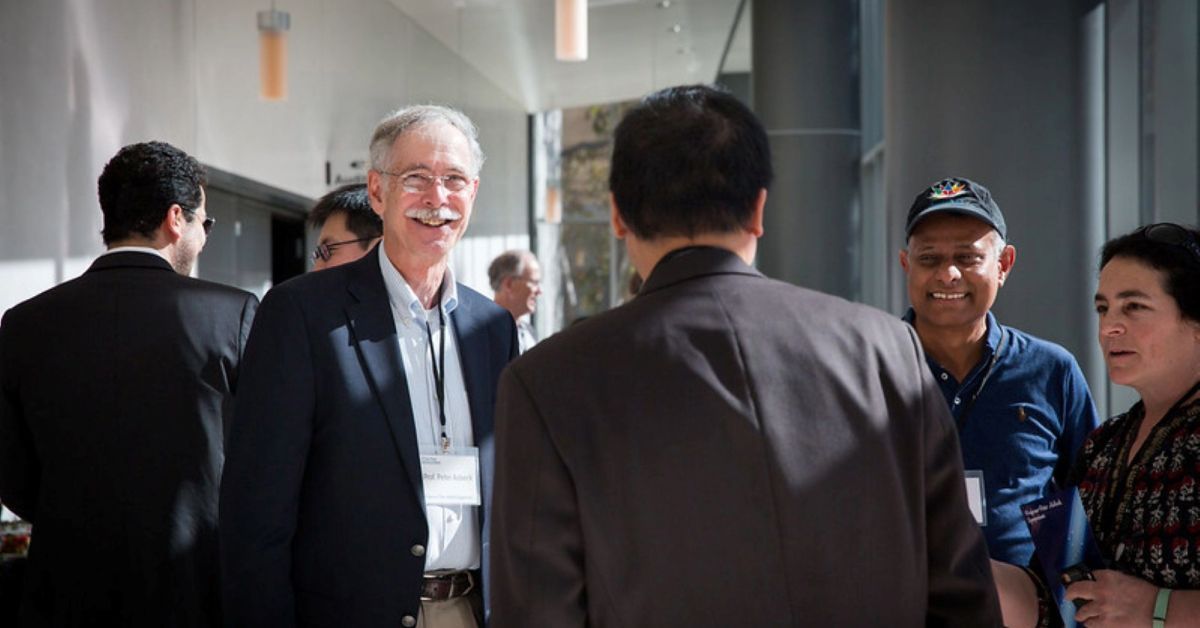Powering 6G
Published Date
Story by:
Media contact:
Topics covered:
- Qualcomm Institute
- Electrical Engineering
- Center for Wireless Communications
- Engineering
- Jacobs School of Engineering
Share This:
Article Content
Professor Emeritus Peter Asbeck doesn’t often step into the spotlight. But when you have more than 20 patents to your name and your innovations help power nearly every mobile phone on the planet, the spotlight tends to find you anyway.
Although he’s been officially retired from teaching electrical engineering at UC San Diego’s Jacobs School of Engineering since 2018, Asbeck remains a key player in the world of wireless communications and a frequent sight around the Qualcomm Institute’s home in Atkinson Hall. He’s widely recognized as a pioneer in compound semiconductor technology and power amplifiers for wireless systems, both of which are essential to efficient communication in smartphones and base stations alike.
Now, he’s tackling a new frontier: sixth-generation wireless communication, also known as 6G.
From South America to Semiconductors
Asbeck spent most of his young life in Venezuela, although he was born in Cleveland, Ohio. After returning stateside, he pursued electrical engineering at the Massachusetts Institute of Technology; there, his fascination with non-silicon semiconductors quickly took root.

That intrigue quickly led him to research positions at Philips Labs and Rockwell Science Center (now Teledyne Scientific). There, he worked on gallium arsenide (GaAs) lasers and field effect transistors. He then led the development of GaAs heterojunction bipolar transistors (HBTs), which amplify signals to improve communications.
When Asbeck joined UC San Diego’s Department of Electrical and Computer Engineering in the early 1990s, wireless communication was still in its early days.
His goal was simple: improve how efficiently mobile devices transmit signals. To do that, he focused on power amplifiers — the HBT technology he had developed was just the thing to use. In later years he focused also on silicon-on-insulator and gallium nitride (GaN) transistors for the amplifiers.
As wireless data rates have increased a millionfold over the past three decades — faster even than Moore’s Law — amplifiers have struggled to keep up. Asbeck explained that doing so successfully requires advanced amplifier designs and non-silicon semiconductors.
“The amplifiers have to be very accurate and very efficient,” he said. “I’ve been fortunate to be part of the development of different transistor technologies and also of various circuit architectures that go along with them.”
Wireless, Efficient and Everywhere
Throughout his career at UC San Diego, Asbeck and his team have relied on federal funding to explore how materials like GaAs and GaN could be used to develop more efficient and accurate power amplifiers. He also was one of the co-founders of UC San Diego’s Center for Wireless Communications, which receives funding from a host of industrial sponsors.
“I was the lead developer 45 years ago,” Asbeck said of GaAs HBTs. “It goes back quite a while but that technology has actually persisted over the years without very many modifications since the days I worked on it.”
The technology still powers most smartphones; Asbeck was elected to the National Academy of Engineering in 2007, largely for his work in this area.
Asbeck was also instrumental in the early years of GaN transistors; he cites the “Aha!” moment of understanding how these transistors work as one of the most enjoyable of his career.
Asbeck also played a role in adapting silicon-on-insulator technologies for microwave circuits, partnering with the Navy lab at Point Loma to develop silicon-on-sapphire devices for amplifiers and switches. Their successors, silicon-on-insulator devices, are now widely used in most wireless systems.
Post-retirement, Asbeck remains actively involved in research at QI, leveraging its state-of-the-art facilities to continue his exploration of advanced circuits. Asbeck explained that the multidisciplinary, resource-rich institute provides an ideal environment for his ongoing research.
The Circuit Labs has been instrumental, he explained. There, Asbeck has many past and on-going collaborations with Don Kimball, Vincent Leung and Sravya Alluri. The Nano3 Nanofabrication Cleanroom Facility is another important location.
There, Asbeck’s lab is exploring new ways to couple semiconductors and circuit boards into a neat package using advanced bonding techniques.
Embracing Innovation at QI
Also at QI, Asbeck is stepping outside his comfort zone into a new realm to satisfy his wide-ranging intellectual curiosity.
A current side project? Figuring out new ways to treat depression and addiction.
“We’ve been trying to simplify repetitive transcranial magnetic stimulation (rTMS),” he said. Asbeck explained that this therapeutic technology uses a combination of coils and electrical pulses to create magnetic fields that interact with the brain and induce neural activity. “We’ve been exploring ways to make these systems more compact and portable so it lowers the barrier to treatment access.”
Even though it’s outside his usual field, it’s this openness to experimentation that’s sustained Asbeck’s enthusiasm well into “retirement.”
“Engineering lets you be creative, get your hands dirty and understand high-tech systems in a way that’s both challenging and fun,” he explained.
His lab’s strong connections to industry partners have also been a defining feature of his time on the electrical engineering faculty at UC San Diego.
“Industry-academia collaboration isn’t as common as it once was,” he said, although he noted that San Diego itself is a hotbed for cooperation, particularly for wireless communications. “At this university, and especially at QI, we’ve worked hard to keep that bridge open so we all benefit from that closeness.”

Topics covered:
- Qualcomm Institute
- Electrical Engineering
- Center for Wireless Communications
- Engineering
- Jacobs School of Engineering
Share This:
You May Also Like
Stay in the Know
Keep up with all the latest from UC San Diego. Subscribe to the newsletter today.




